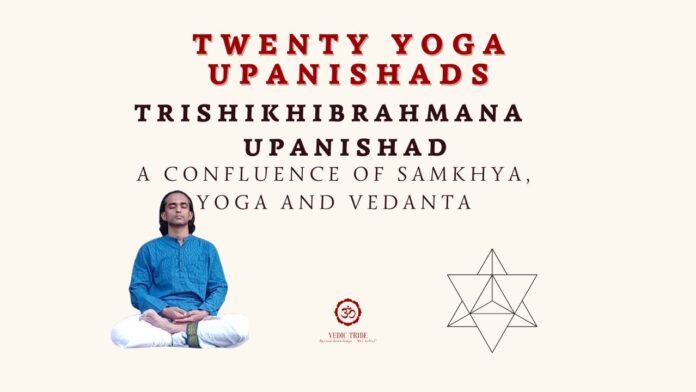A confluence of Samkhya, Yoga and Vedanta:
In the previous article, we discussed the Yogatattva Upanishad. In this article, we will delve into the Trishikhibrahmana Upanishad.
The Trishikhibrahmana Upanishad is a significant text in the realm of Yoga philosophy. It is renowned for its balanced approach to spiritual practice, integrating elements from Samkhya, Yoga, and Vedanta.
It also integrates Karma Yoga (the path of selfless action) and Jnana Yoga (the path of knowledge) for holistic spiritual development.
Cosmic Model and Creation
The Upanishad presents a cosmic model based on the principle of cause and effect, drawing inspiration from the ancient Samkhya school of thought. It explains that the universe emerges from the subtle to the gross, ie.m from a dimensionless source to a vibrant visible reality.
Cause and effect: It presents a structured cosmic model, a framework for understanding how the manifest world arises. The model is based on the fundamental principle of cause and effect, where each stage of creation is a consequence of the preceding one.
From Primordial Nature: The Upanishad describes the origin of the universe as a dimensionless source, a state of pure potentiality. This aligns with Samkhya’s concept of Mula Prakriti, the unmanifest, primordial nature.
Samkhya model: The Upanishad draws heavily from the Samkhya school of philosophy. The Upanishad adopts Samkhya’s concept of Prakriti as the origin of the universe, and it uses Samkhya’s system of how Prakriti evolves. Samkhya’s evolutionary process, which moves from the subtle to the gross, is a core element of the Upanishad’s model.
Avyakta – It indicates dimensionless proto nature – “moola prakriti.
Mahat – It indicates the gross nature with dimensions. I.e., The dimensionless proto-nature becomes gross nature with dimensions.
Ahankara – It indicates “gross mind”. This is the universal mind which becomes part of our body as the subtle mind. In all the sentient beings this gross mind manifest the sentience necessary to operate.
The rest – From Ahankara or the “gross mind” emerges rest of the physical elements.
Nature of cosmos: The universe is not created ex nihilo (out of nothing), but rather transformed from a pre-existing state.
Gradual Unfolding – The manifestation of reality is a gradual unfolding, a progressive evolution from potentiality to actuality.
Hierarchical Structure – The universe is structured hierarchically, with each level of reality emerging from and dependent on the preceding level.
Ashtanga Yoga
The Upanishad outlines the eight limbs of yoga, as detailed in Patanjali’s Yoga Sutras: Yama, Niyama, Asana, Pranayama, Pratyahara, Dharana, Dhyana, and Samadhi.
The Integration of Karma Yoga and Jnana Yoga
The Upanishad advocates for a balanced approach to spiritual growth, recognizing that knowledge alone is insufficient, and action without understanding can be misdirected. It proposes that true spiritual progress requires the harmonious development of both the intellectual and practical dimensions of life.
Karma Yoga: Karma Yoga is the path of selfless action, where actions are performed without attachment to their fruits or results. It involves fulfilling one’s duties and responsibilities with dedication and detachment. In the context of the Trishikhibrahmana Upanishad, Karma Yoga is closely linked to observing the virtues and teachings of the Vedas.
Jnana Yoga: Jnana Yoga is the path of knowledge and wisdom, which involves the intellectual understanding of the ultimate reality. It is the path of discrimination between the real and the unreal, the eternal and the transient. In the Upanishad, Jnana Yoga involves the intellectual understanding of the Vedas’ essence.
The integration: The Trishikhibrahmana Upanishad emphasizes that Karma Yoga and Jnana Yoga are not mutually exclusive but rather complementary paths. Action without knowledge can lead to blind adherence to rituals and dogmas, while knowledge without action can remain theoretical and ineffective. This integration ensures that spiritual development is both grounded in ethical action and illuminated by profound wisdom. This approach is a very balanced way to live a spiritual life.
Key takeaways:
– Study Trishikhibrahmana Upanishad and understand its meaning from a scholar and adopt teachings of this Upanishad in your spiritual practices.
– Also study Samkhya Philosophy and enjoy the rich philosophical deliberation in the Vedic school of thought.
In the next article, we will discuss – “Yogachudamani Upanishad”.
Madhwesh K
Vedic Tribe

